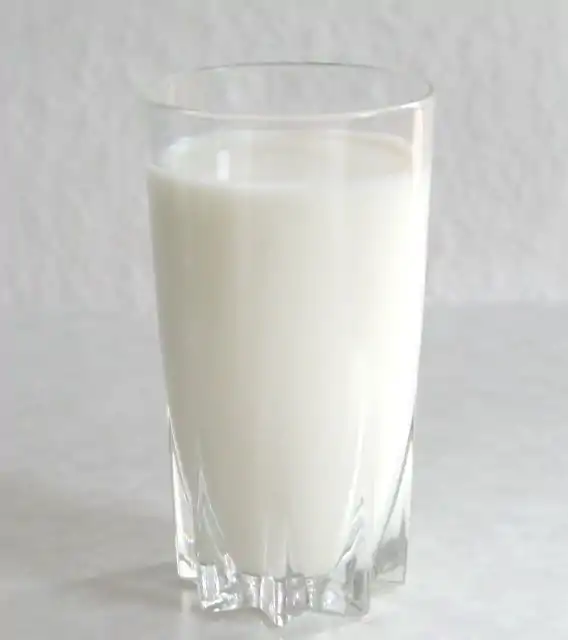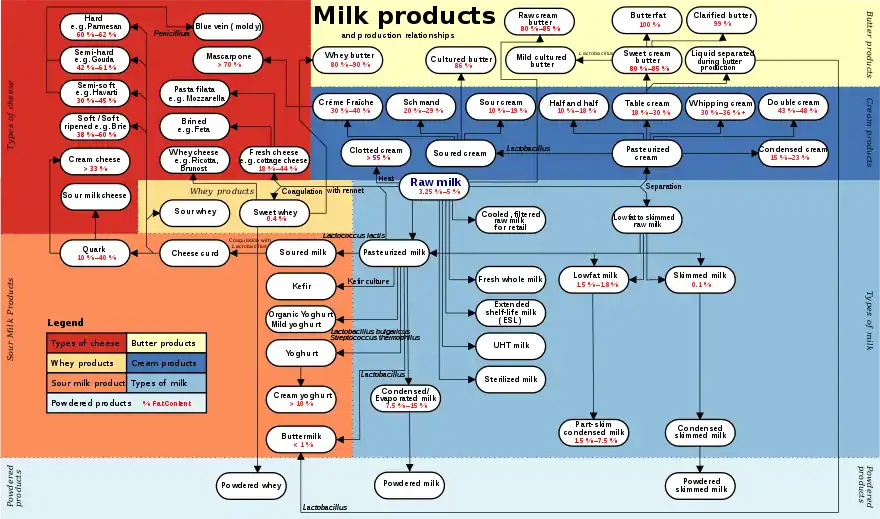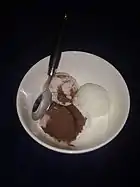|
 Milk glass Milk glass |

Dairy products or milk products are a type of food produced from or containing the milk of mammals. They are primarily produced from mammals such as cattle, water buffaloes, goats, sheep, camels and humans. Dairy products include food items such as yogurt, cheese and butter.[1][2]
Types of dairy product
Milk
Milk is produced after optional homogenization or pasteurization, in several grades after standardization of the fat level, and possible addition of the bacteria Streptococcus lactis and Leuconostoc citrovorum. Milk can be broken down into several different categories based on type of product produced, including cream, butter, cheese, infant formula, and yogurt.
Milk varies in fat content. Skim milk is milk with zero fat, while whole milk products contain fat.
- Scalded milk
- Condensed milk, milk which has been concentrated by evaporation, with sugar added for reduced process time and longer life in an opened can
- Evaporated milk, (less concentrated than condensed) milk without added sugar
- Baked milk is milk simmered on low heat for long time which results in mild caramelization. Particularly popular in Eastern Europe.
- Dulce de leche
- Malai
- Powdered milk (or milk powder), produced by removing the water from (usually skim) milk
- Khoa, milk which has been completely concentrated by evaporation, used in Indian cuisine
- Infant formula, dried milk powder with specific additives for feeding human infants
- High milk-fat and nutritional products (for infant formulas)
- Whey, the liquid drained from curds and used for further processing or as a livestock feed
- Buttermilk, the liquid left over after producing butter from cream, often dried as livestock feed
- Milk skin
Milk is an ingredient in many confectioneries. Milk can be added to chocolate to produce Milk chocolate.
Fermented milk
Template:Div-col
Yogurt
Yogurt, milk fermented by thermophilic bacteria, mainlyStreptococcus salivarius ssp. thermophilus and Lactobacillus delbrueckii ssp. bulgaricus sometimes with additional bacteria, such as Lactobacillus acidophilus Template:Div-col
Cream
Template:Div-col
Butter
Butter, mostly milk fat, produced by churning cream
- Ghee, clarified butter, by gentle heating of butter and removal of the solid matter
- Smen, a fermented, clarified butter used in Moroccan cooking
- Anhydrous milkfat (clarified butter)
Cheese
Cheese, produced by coagulating milk, separating from whey and letting it ripen, generally with bacteria and sometimes also with certain molds Template:Div-col
Casein
Casein Template:Div-col
Custard
Custard
- Vla
Ice cream

- Ice cream, slowly frozen cream, milk, flavors and emulsifying additives (dairy ice cream)
- Gelato, slowly frozen milk and water, lesser fat than ice cream
- Ice milk, low-fat version of ice cream
- Frozen custard
- Frozen yogurt, yogurt with emulsifiers
Processing Techniques
MILKFAT REMOVAL
STORAGE
NUTRITION
NATURAL CHEESES
Cheese Varieties
PROCESSED CHEESES
SERVING CHEESES
COOKING WITH CHEESE

References
- Wikipedia article:Dairy product
- Wikipedia article:Milk
- Wikipedia article:Cream
- Wikipedia article:Butter
- Wikipedia article: Cheese
- Wikipedia article: Casein
- Wikipedia article: Custard
- Wikipedia article: Margarine
- Wikipedia article: Types of cheese
- Wikipedia article: Processed cheese
- Wikipedia article: PASTEURIZATION
- Wikipedia article: Ultra-high-temperature processing
- Wikipedia article: HOMOGENIZATION
- Wikipedia article: Goat cheese
- Wikipedia article: Fermented milk products